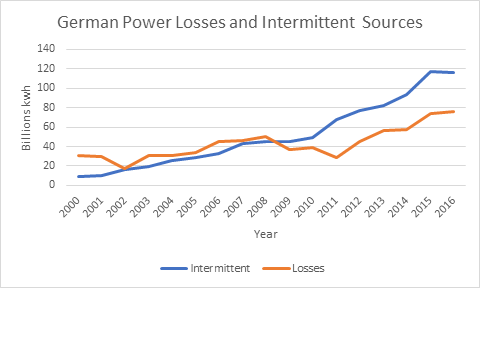Why are areas where wind and solar are being used have such high utility bills? In an interview on ABC-TV, Prof. Bruce Mountain, says that in South Australia the problem is that there is that there is not enough power from wind and solar:
“Every additional unit of production you get from the wind or from the sun, that displaces gas generation, and brings your price down”
Is that true? It seems to be a truism that additional electricity from the wind or sun will displace gas (or fossil fuel) generation. We often hear of advocates for wind power wanting to supply 30% or more of the power in the grid. Can high amounts of intermittent power be utilized effectively?
For answers, consider the following graph of intermittent power (wind+solar) in Germany and losses (generation – consumption) for the years 2000 – 2016.
 As you can see, starting in 2011, the losses begin rising in parallel with the rise in intermittent power. In 2011, the 68 billion kWh generated by wind and solar represented 11.8% of the power generated that year. That appears to be the maximum that the grid can absorb. After that, power from the sun and wind just added to the losses in the system, and the grid tried to rid itself of them before it caused a blackout.
As you can see, starting in 2011, the losses begin rising in parallel with the rise in intermittent power. In 2011, the 68 billion kWh generated by wind and solar represented 11.8% of the power generated that year. That appears to be the maximum that the grid can absorb. After that, power from the sun and wind just added to the losses in the system, and the grid tried to rid itself of them before it caused a blackout.
This explains why the German CO2 emissions refuse to go down. The amount of power generated from fossil fuels was 339 billion kWh in both 2000 and 2016. Since the same amount of power is being generated with fossil fuels, the same amount of fuel is being consumed and the carbon footprint stays the same.
Despite generating 31.8% of its power from renewables in 2016, Germany is not decarbonizing. The graph shows that adding wind and solar power beyond what can be used to satisfy demand is useless. The power is dissipated as heat or dumped outside the system. This does nothing to decarbonize the country.
What is not dumped are the feed-in tariffs, or in the case of Australia, Renewable Energy Certificates (REC). The money paid to the owner of wind turbines and photovoltaic cells for their electricity still shows up on the ratepayer’s bills, even though the power was not used. This includes the feed-in tariff.
The ratepayer pays for the following: power he uses, tariffs on 12% of the power he uses, useless power and tariffs on that power, tariffs on power that businesses who are big enough to get an exemption use, a ‘strengthened’ grid and ‘strengthened’ interconnectors to dump useless power elsewhere, load shedding equipment and load management equipment for when the wind dies down too quickly to avoid a blackout, and big, expensive batteries.
More energy from the wind and sun will not do a thing to reduce gas generation in South Australia because the grid is already saturated with intermittent energy. Since the energy cannot be used effectively, the amount of electricity generated by gas will not go down. The only thing it does is increase energy costs and blackouts.
It is small wonder then, that the more wind and solar you have in a system, the higher the electric bill.
Source:
All data was sourced from the US EIA. Unfortunately, this is a beta site, but there was no other link to international data yet.
This website has CO2 emissions, generation and consumption figures for every country for the years 1980-2016. This link will make available for download German CO2 emissions.
The link for German electricity generation is:
The link for German electricity consumption is: